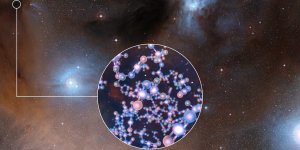| News / Space News |
Astronomers confounded by massive rocky world
NASA | JUNE 3, 2014
Astronomers have discovered a rocky planet that weighs 17 times as much as Earth and is more than twice as large in size. This discovery has planet formation theorists challenged to explain how such a world could have formed.

An artist's conception shows the Kepler-10 system, home to two rocky planets. Image credit: Harvard-Smithsonian Center for Astrophysics/David Aguilar
Kepler-10c, as the planet had been named, had a previously measured size of 2.3 times larger than Earth, but its mass was not known until now. The team used the HARPS-North instrument on the Telescopio Nazionale Galileo in the Canary Islands to conduct follow-up observations to obtain a mass measurement of the rocky behemoth.
It was thought worlds such as this could not possibly exist. The enormous gravitational force of such a massive body would accrete a gas envelope during formation, ballooning the planet to a gas giant the size of Neptune or even Jupiter. However, this planet is thought to be solid, composed primarily of rock.
Kepler-10c orbits a sun-like star every 45 days, making it too hot to sustain life as we know it. It is located about 560 light-years from Earth in the constellation Draco. The system also hosts Kepler-10b, the first rocky planet discovered in the Kepler data.
YOU MAY ALSO LIKE



